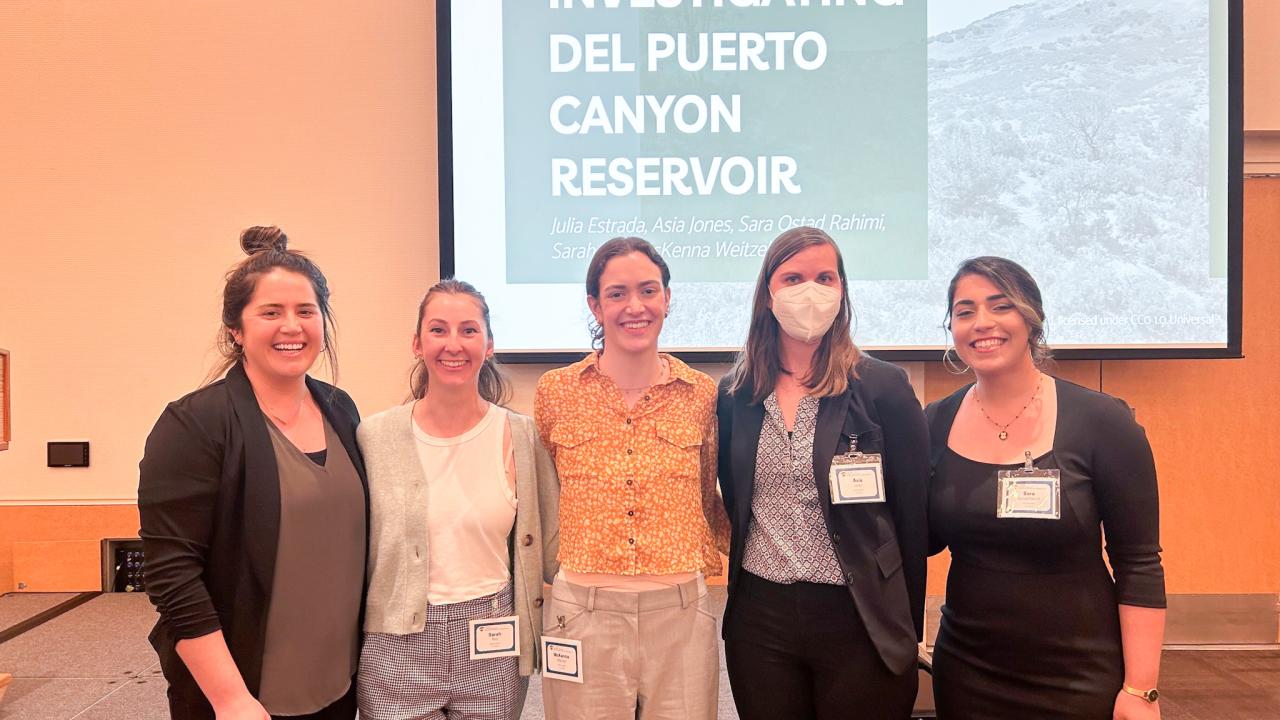
Working with Friends of the River to Save Del Puerto Canyon
Quick Summary
- Our Policy Clinic team partnered with the non-profit organization Friends of the River to better understand the potential impacts of the proposed Del Puerto Canyon Reservoir.
This blog is the last of a series of seven, where Environmental Policy and Management students write about the capstone projects they have worked on since January in partnership with external organizations. We want to acknowledge and thank our client, Keiko Mertz, with Friends of the River.
The City of Patterson, California is a small, rural town located off Interstate 5 in Stanislaus County. According to the 2020 Census, Patterson is home to around 23,781 people, 68.1% of whom are Hispanic and 57.7% of whom are white. Spanish is reportedly the most commonly spoken language at home. To the west of the town sits Del Puerto Canyon (DPC), an expansive range of rolling hills and the site of the Del Puerto Water District’s (DPWD) proposed reservoir.
DPC is anecdotally known to be a major site for gathering and recreation–a fact for which our research provides further evidence. Its hills are full of unique fossils and cultural resources which continue to attract visitors and researchers from across the region. Boasting a mixture of oak, wetland, and riparian habitat, the Canyon is home to a diversity of wildlife and several special status species such as burrowing owl (Athene cunicularia), fairy fan (Clarkia breweri), and chaparral clarkia (Clarkia affinis).
Data from our surveys and interviews reveal that, in the last year, at least 163 people visited the Canyon to engage in activities like biking, hiking, and birding. On top of this, nearly 30 colleges, universities, and other organizations indicated that they regularly use the Canyon for education and research. These numbers help convey, in numeric terms, the importance of DPC as a local recreational, educational, and cultural resource, however they likely undercount several aspects of Canyon visitation due to limitations in survey response rate and distribution.
Many community members feel that the Canyon has been systematically undervalued, while the advantage of the project has been consistently overstated. Our analysis indicates that several of the proposed benefits regarding increased water storage and reduced flood risk may be overstated given, among other things, California’s rapidly warming climate.
There has been additional concern surrounding the project’s Environmental Impact Report (EIR)–a document examining the potential environmental impacts of projects like the Del Puerto Canyon Reservoir. An adequate EIR is required by California law, as is the opportunity for the public to participate in the review. When the reservoir was proposed, however, information was not translated or distributed in Spanish and meetings were held during working hours.
This proposed reservoir has the potential to reduce open space for the nearby community of Patterson and flood precious educational, geological, cultural, and environmental resources. Because green space is exceedingly rare in the Central Valley and known for its multitude of benefits to individuals and local communities, the need to quantify the Canyon’s use and by whom is imperative.
Our team has been working with both Friends of the River (FOR) and Save Del Puerto Canyon (SDPC) to help assess the Canyon’s usage and evaluate the merits of the proposed Del Puerto Canyon Reservoir. FOR is an advocacy organization whose mission is to “protect and restore California rivers by influencing public policy and inspiring citizen action.” They aspire to preserve, protect and restore California’s rivers.
FOR partners with grassroots organizations, like SDPC, to strengthen and support organizational capacity. SDPC is a community-based grassroots organization formed in response to the proposed reservoir project.
Our goal in working with these organizations has been to quantify and qualify as many of the DPC resources as possible through surveys and interviews to provide evidence of its value to the community. Our survey was distributed to the people of Patterson via paper mailer, email, Facebook, and various public spaces. It provided insight as to how far and how often people traveled to the DPC, their reasons for visiting, and their opinions on the proposed project. Alongside our informational interviews, survey data informed us about the costs of travel to DPC and the values people attach to this important site.
One of our most interesting findings was that despite only 163 people taking our survey, those respondents traveled between 30,000 and 50,000 miles annually to visit DPC in total. We assume that this is a gross underestimate of the visitation DPC receives each year due to the limited time of our study. Our work is compiled and explained in further detail within an Economic Valuation Report and an Environmental Justice Memo that will be available on FOR’s website in the coming weeks.
We have enjoyed working with the community and non-profit organizations on a project that can be used in future public advocacy efforts. The proposed DPC Reservoir project has the potential to have significant environmental and social impacts on the Patterson community. We hope our efforts to formally quantify and qualify the value of this area to the community, and beyond, can contribute to protecting the Canyon's natural resources and ensuring equitable treatment for all involved parties.
